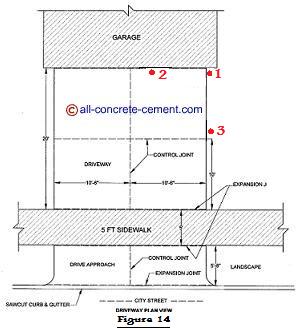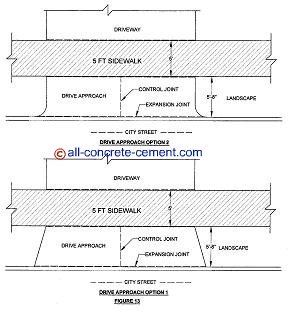|
[?]Subscribe To This Site
|
Cement DrivewayCement driveway is a continuation of garage floors, connecting the street to the concrete garage floor. Should driveways are not properly formed water flow from city street can cause major drainage problems which can lead to lost in property value. For carport or garage ideas over your driveway click here This page is the second part of cement drivewaysAt this stage, let's discuss how to form cement driveways. The thickness of the driveway slab will determine the size of lumber to be used for forming. For garage floor thickness and cement driveway thickness, I never use anything more than 4 inches thick. As far as reinforcements, 4 inch thick unreinforced slab is what I use for driveways. Unless you plan on driving heavy equipment on your slab, I don’t see any need for reinforcements. A 4000 psi concrete mix, 4 inch thick driveway is pretty hefty for your normal family use.
The forming material needed for the driveway in figure 14 will be 2x4s, two 12 footers and two 8 footers should do. To begin forming, the first thing to do is establish point #1 as shown on figure 14. Since city sidewalk and streets are not square with your garage, it is a good idea to make sure your driveway is at right angle with your garage. To make sure the driveway is at 90 degrees angle with the garage, we need to use 3, 4, 5 triangle or combinations of it. The 3, 4, 5 triangle is from Pythegorean Theorem which states that a triangle with short leg of 3 and longer leg of 4, if the hypotenus between these two points is 5 than the triangle is a right angle triangle or 90 degree. Let’s use multiple of 3 so that the 3, 4, 5 becomes 9, 12, 15. From point#1, (refer to figure 14) measure 9 feet to point 2. Again from point 1 measure 12 feet to point 3. From point 2 measure 15 feet to point 3, move point 3, if necessary to where the 15 feet mark. By joining points 1 and 3 straight to the sidewalk, the driveway will be squared with the garage. In other words, your driveway and garage floor line form 90 degrees. Once points 1 and 3 are established, pull a string line from point 1 to the sidewalk making sure the string aligns with point 3. The height of the string should align with top of garage floor at point 1 and the opposite end at top of sidewalk. When placing the 2x4 forms, make sure the top matches the string height. With a slash hammer, pound steel or wood stakes every 5 feet with one side of the steel stake barely touches the string. Place the 2x4 form against the steel stakes installed. With the slash hammer again, install steel stakes at the opposite side such that the 2x4 is being sandwiched between two stakes. After the height and straightness of the 2x4 is adjusted, nail the stake to the 2x4 and remove the stakes on the opposite side. Make sure the face of the 2x4 that will receive the concrete follows the string precisely. Likewise the top of the 2x4 must match height of the string. Repeat the process until all the perimeter forms are in place. It is not uncommon to leave both stakes in and pull the interior as you pour. It is a good idea after placing the string to measure the height of the string and make necessary adjustments such as digging out or backfilling and compaction where needed prior to placing the forms.
The thickness of the drive approach is determined by the city's building division. If 6 inches thick, we will need 2x6 board for form work. Drive approach option 1 per figure 13 is pretty simple to do. Just place one end of a straight 2x6 to align with the line of the driveway and place the opposite end at the desired flared. You might need to trim the edges of the 2x6 to 45 degree cut to ensure proper closure at the end. Option 2 is a little complicated to form. For a small piece of curvature such as this, I would use an expansion joint material for forming. I would nail one end of a piece of expansion joint to a straight piece of 2x6. With steel stakes spaced 6 inches on center, both sides of the expansion joint, adjust the expansion joint to the desired curvature.Other materials that I have used to form curve includes steel plates, particle boards, wafer board, and plywood. You can cut 3.5 inches wide or 5.5 inches for 6 inches thick slab from these material and use them for forming. For carport or garage ideas over your driveway click here To shop for concrete cutting plate click here Back to the top |
|






 After the driveway is formed, we are ready to form the drive approach. Refer to figure 13 as it shows two options for the drive approach. Personally, I prefer option 1 because the circular edge at option 2 makes the concrete too thin that it will easily break.
After the driveway is formed, we are ready to form the drive approach. Refer to figure 13 as it shows two options for the drive approach. Personally, I prefer option 1 because the circular edge at option 2 makes the concrete too thin that it will easily break.